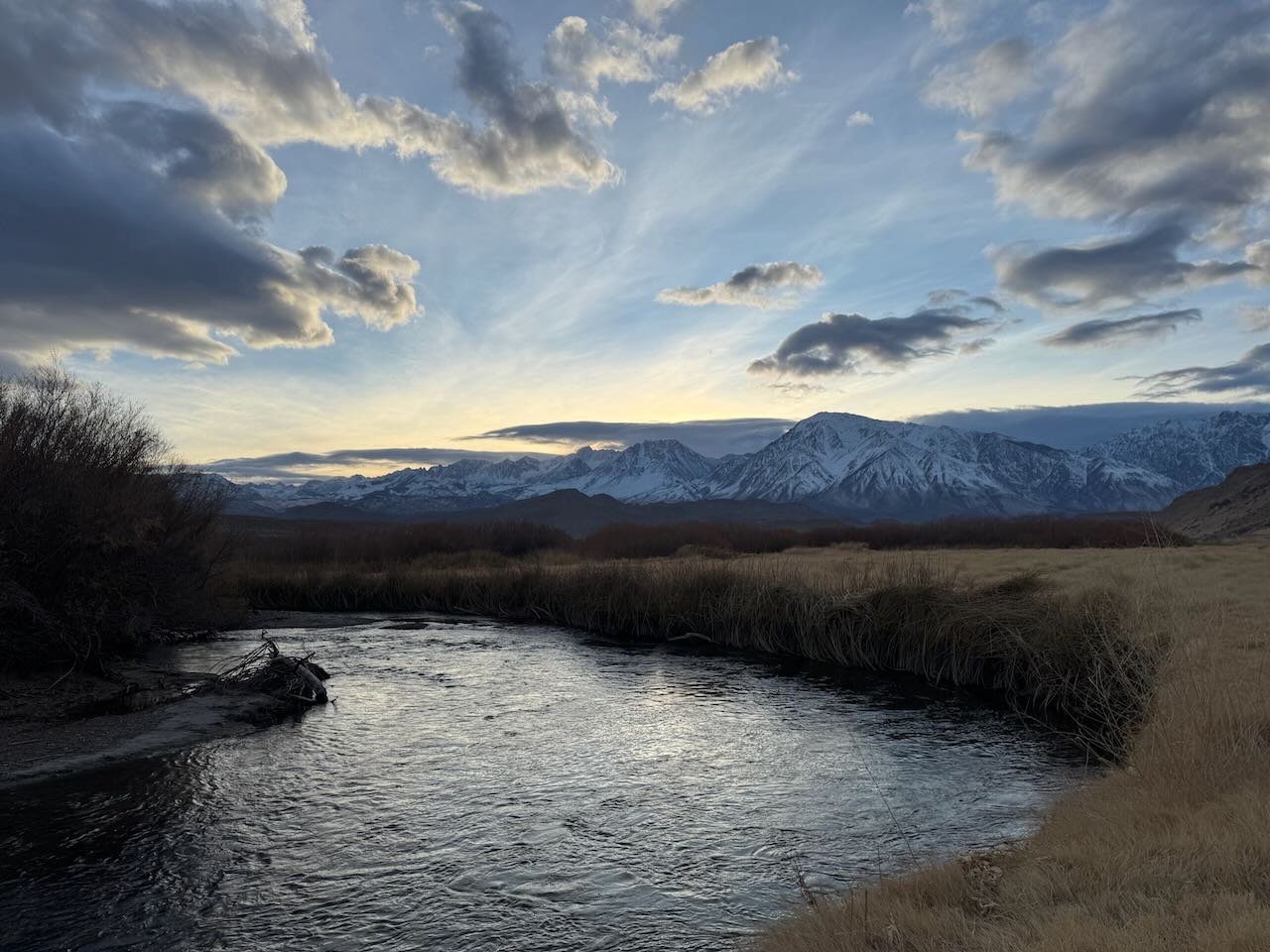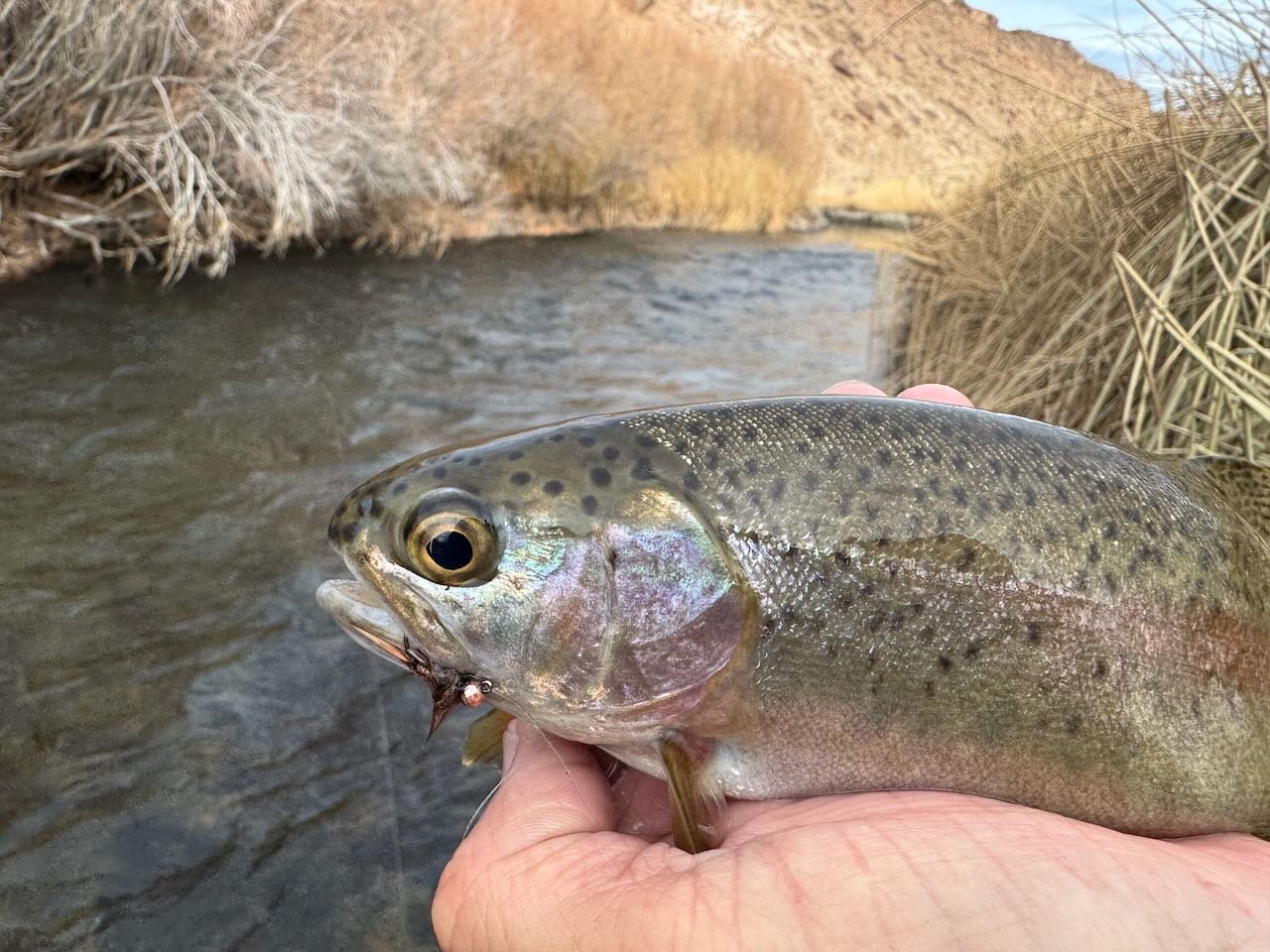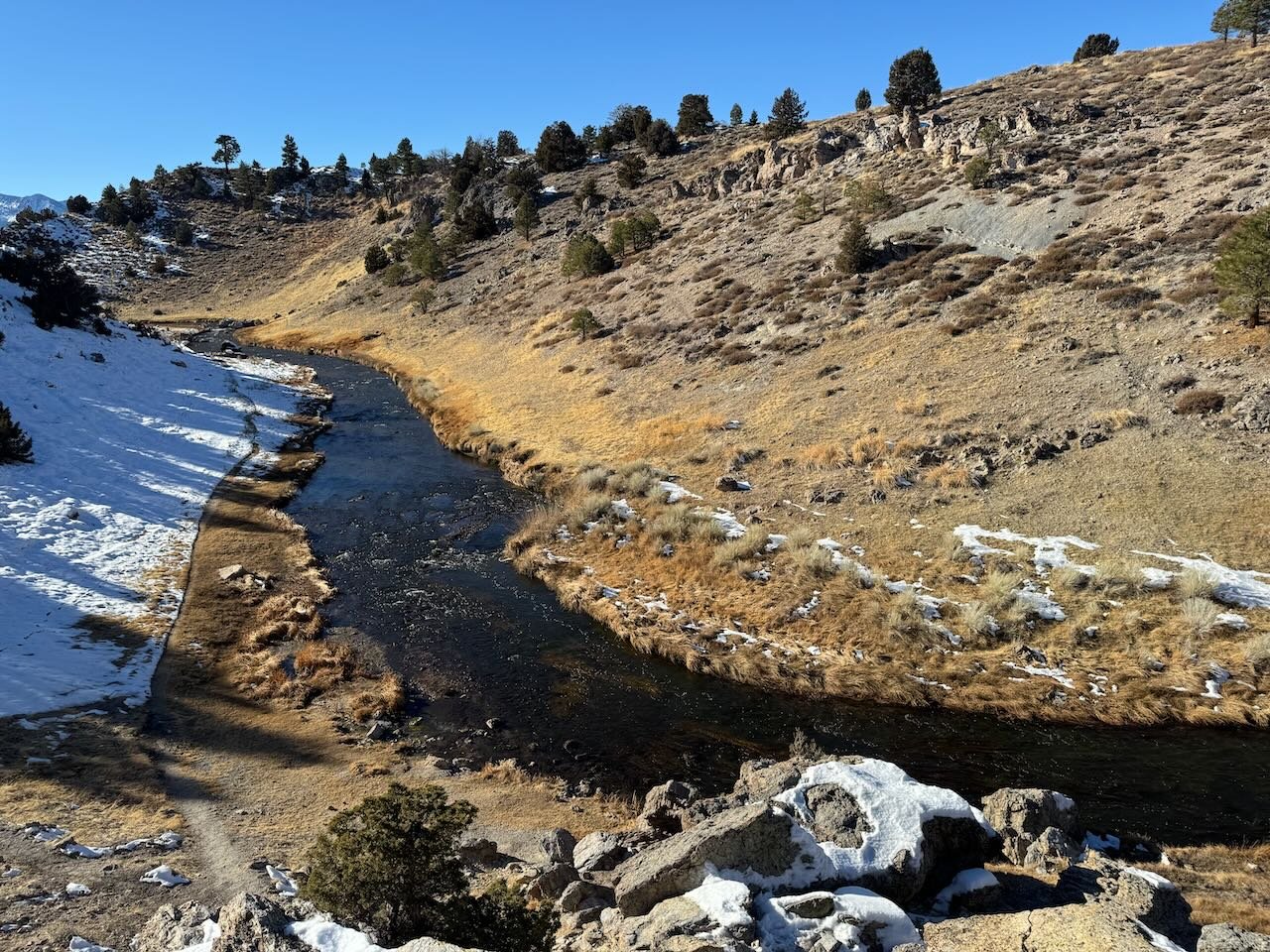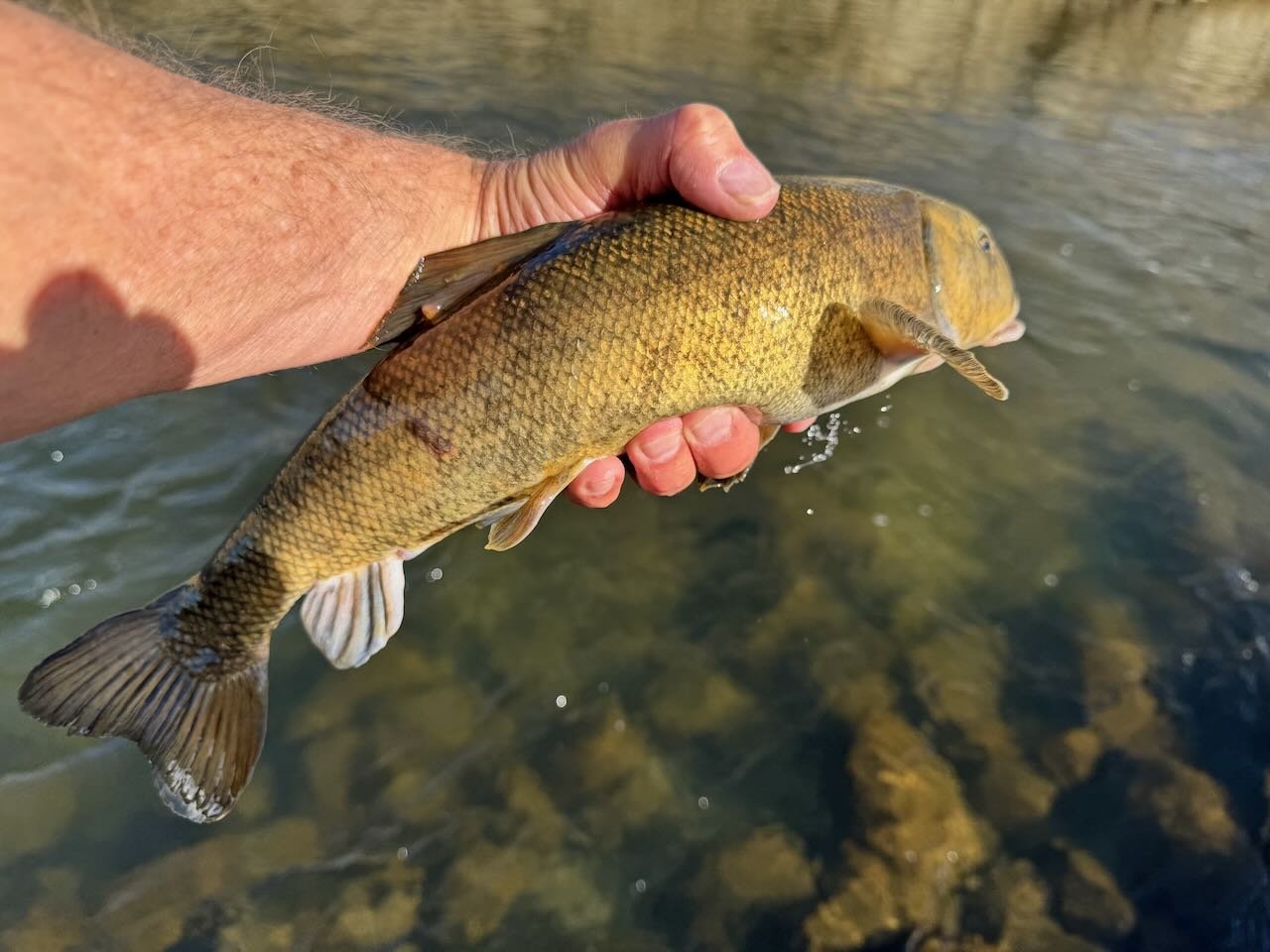If you are looking for tips on fly fishing techniques on Eastern Sierra waters, upcoming events and where the best Eastern Sierra weekend fly fishing spot is, sign up for the email on the webpage at https://www.sierrabrightdot.com
It’s that time of the year when quick moving storms are coming through the Eastern Sierra and laying a few inches to a foot of snow. Roads in the Long Valley area are muddy, snowy and have icy mud puddles. I would use high clearance vehicles with four wheel drive on these roads. In between storms the weather has been nice by winter standards. Mayflies, midges and caddis are providing the food for the winter feeding trout. There is limited dry fly opportunities for the die hard dry fly angler.
Winter storms are moving through the Sierra leaving snow at upper elevations.
Lower Owens River
Wild Trout Section:
Middle of the day is providing good nymph fishing opportunities with an indicator rig or a Euro nymph rig. Key to success is getting the nymphs to bounce on the substrate like the naturals do. Accomplish this with using the right combination of flies and split shot to allow your flies to bounce along the substrate just like the naturals do. Nymphing with size 18 olive quilldigons, size 18 bead head flash back pheasant tail nymphs, size 18 slim shadies, size 18 Jedi Master baetis, size 12 stoner nymphs, size 14 copper John’s, and size 20 midges in tiger, zebra and blood colorations are producing the wild trout of the lower Owens River. There has been limited dry fly action with size 20 blue wing olive parachutes. If you are in the right hole when the hatch takes place and the trout are feeding on the surface emerger mayflies then switch to a dry fly and enjoy some late season dry fly action.
Rainbow trout have been making up 30 to 50 % of the catch in the lower Owens River on nymphs like this size 12 stoner nymph that fooled this chunky rainbow..
Hot Creek
Interpretive Site:
Snow and ice are on the dirt road leading into the interpretive site. For fly fishers looking for some dry fly action this section of the creek is providing top water action with mayfly and midge hatches. Size 20 blue wing olive parachutes, size 20 olive sparkle duns and size 20 Griffith’s gnats are fooling the surface feeding trout. The action has been during the middle of the day from 10:00 to 2:00. A drag free drift, the right dry fly pattern and lots of hatching insects is what is going to produce a great dry fly day on the creek in winter time.
Warm days after the snow storms is melting the snow on the south side of Hot Creek in the canyon section which is a great place to fish with a dry and dropper rig..
Hot Creek
Canyon Section:
Snow and mud puddles are the obstacles fly fishers will encounter on the dirt road leading into the Canyon Section of Hot Creek. This is a great time to be nymph fishing with a dry and dropper rig or a Euro nymph rig. Size 18 olive quilldigons, size 18 bead head flash back pheasant tail nymphs, size 18 slim shady, size 18 Jedi Master baetis, size 12 olive scuds, size 12 olive burlap caddis and size 20 blood, zebra and tiger coloration midge patterns are producing wild brown and rainbow trout in the canyon section of Hot Creek.
A size 12 stoner nymph is my number one producing trophy trout pattern in the upper Owens River.
Upper Owens River
Above Benton Crossing Bridge:
The dirt roads accessing the upper Owens River above Benton Crossing Bridge are full of snow, frozen mud puddles and lots of squishy mud. Four wheel drive high clearance vehicles are what is needed to access the sections of the upper Owens River holding trophy rainbow trout. Two to four trophy rainbow trout per fly fisher per session is what the river is producing for fly fishers. Euro nymphing or indicator nymphing with size 12 stoner nymphs, size 12 green/gold wire Prince nymphs, size 12 gold ribbed hare’s ears variations, size 14 copper John’s and size 12 rainbow warriors are the flies fooling the trophy rainbow trout. Key to success is getting the flies on the substrate in the deep holes, deep runs and cut banks where the rainbows are resting and feeding. When using an indicator be sure the indicator is six feet above the bottom fly. Using the right combination of weight and flies is what is needed to allow the flies to bounce along the substrate where the trout are feeding. Size 16 hot spot pheasant tail nymphs, size 18 olive quilldigons, size 16 SOS nymphs, and size 18 bead head flash back pheasant tail nymphs are fooling the resident browns and rainbows.
Suckers are not every ones preferred species to catch on the fly, but suckers put up the best fights of fish I catch in Bishop Creek Canal.
Bishop Creek Canal
Behind Bishop Veterinary Hospital:
Nymphing in deep holes and riffles is producing suckers, rainbows and brown trout. Dry and dropper, Euro nymphing and indicator nymphing are the methods to get your nymphs down on the substrate where the fish are feeding. Size 18 olive quilldigons, size 12 stoner nymphs, size 16 SOS nymphs, size 18 bead head flash back pheasant tail nymphs and size 20 midges in blood, zebra and tiger coloration are producing wild rainbows, browns and suckers. The fish are supper spooky and fly fishers need to present their flies in a manner that they’re not spooking the fish.





